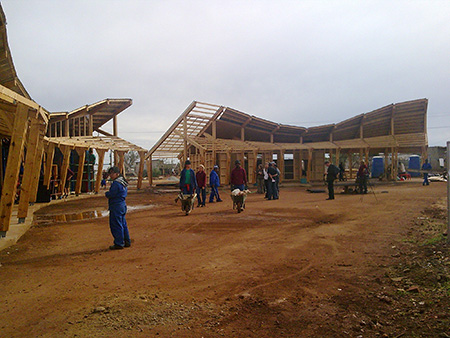Social Architecture
Social Architecture
The Education Africa Social Architecture Project applies the theories of affordable building to impoverished areas inhabited by the poorest of the poor, whose facilities are inadequate and/or non-existent.
The design and building concepts of an international partner university are implemented for the creation of the physical structures, and students from the university come to construct the building, thus encouraging social tourism and the transfer of skills from the university students to unemployed and often uneducated, locals.
Education Africa has partnered with a number of universities and technical universities to build a number of preschools over the past 15 years. Today we are partnering with Nottingham University School of Built Environment and Thušanang Trust in Limpopo Province.

How do Education Africa Social Architecture Projects work?
These socially effective design build projects are incorporated into the academic programme of the partner university where their students design the structure, and a number of students are then selected to physically come and build the preschool facilities over a 6 – 7 week period. The international students are also involved in raising funds for the project.
The centres are designed and constructed by the students using simple inexpensive local building materials, while applying innovative solutions to architectural problems. Often, the students include unemployed local residents in the building of the facilities in order to encourage skills transfer.
Education Africa, through our ECD project and partners, also helps to ensure that partnerships and structures are in place so that the centres will be run and maintained effectively, once built.
See our completed Social Architecture projects below:
Technical University of Vienna designed and constructed a workplace, storage area for tools and materials, cooking and sanitary facilities, an office and a centre for social interaction for Modimo O Moholo home for disabled adults in the Orange Farm community.
Phase 2 of the project (2005) saw the additional construction of living units and additional workshops.
Orange Farm in an impoverished informal settlement south of Johannesburg, and suitable areas for social interaction and work areas were needed so that the centre could become a fully operational workplace.
Technical University of Vienna designed and built a Facility for Security Personnel at Masibambane College. This multi-purpose room, incorporating basic sanitary and cooking facilities is also used as the living quarters for the school security personnel.
University of Art, Linz built a kitchen, laundry and dining areas and therapy rooms for Tebogo Home for mentally and physically handicapped children. The home had been partially destroyed by fire in 2004; thus it desperately needed reparation and upgrading to cater for the children’s needs.
Graz University of Technology built Thembelihle Pre-School in Wielers Farm, an
extraordinarily poor township in need of pre-school facilities. An entirely new facility was
built with adequate play and sleep areas to replace the pre-fabricated shack which had
previously been accommodating 60 children. The new facility accommodates many more
children.
Construction to this creche in the remote area of Mankweng, Limpopo was due to start in April 2020, but had to be put on hold due to the Coronavirus pandemic.
On 6th May we celebrated the much-awaited opening of Malahlela Crèche in the remote area of Mankweng, Limpopo. We are grateful to our partners – Thušanang Trust in Limpopo Province and University of Nottingham Department of Architecture and Built Environment in the United Kingdom – who did the heavy lifting for this design and build project. The building of Malahlela Crèche had to be delayed by two years due to the Covid Pandemic. The new creche features new classrooms, offices, a kitchen, storage facility, toilets and a playground.
Monang Preschool in Ga-Molepo, Limpopo was opened in May. We were proud to facilitate this construction in partnership with the Nottingham University Department of Architecture and Built Environment, and Thusanang Trust.
